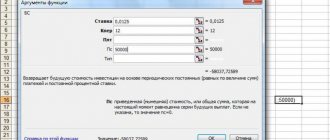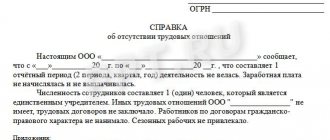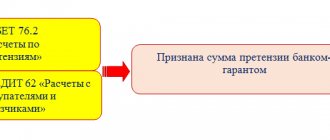During the month, you receive money from customers, pay bills from suppliers, pay salaries, taxes by bank transfer, that is, through a bank.
In order for an LLC or individual entrepreneur to manage their non-cash money, they must open an account in any bank they like. You can find its different names on the Internet, in contracts, in economic literature: “bank”, “settlement”, “current”, “ruble” or even “personal” account.
When the month is over, you take your bank statement . In some banks, and especially in online banking, this is also called an “extended statement”. It is expanded because it shows not only the amount of money that is in your account, but also what date, from which company or individual entrepreneur, what this money came for and some other details of the payment.
Procedure for maintaining a bank account
A current account is opened and maintained at the request of a representative of a legal entity, that is, an enterprise or organization. This can be either the owner himself or an accountant who deals with documentation.
Opening an account, opening it and closing it are the responsibilities of bank employees. However, all operations performed must be carried out and recorded only bilaterally. That is, in the bank by bank employees, and in the organization by the accounting department, which must have an idea of every minimal transaction carried out on the current account.
All transactions are carried out only in cash and with the obligatory presence of accompanying documents. Documents can be in paper or electronic form. Such operations as write-off and accrual are carried out.
A write-off is an operation in which funds are spent from a current account.
Accrual is a banking transaction in which funds are transferred to a bank account.
In order for the debit to be made, there must be a sufficient amount of money in the account. But there are situations when a large number of documents are received on the account that require debiting. And if there are not enough funds in the account to pay payment requests, debits from the account are carried out in turn.
For this purpose, the bank has a strictly distributed order:
- Write-off upon presentation of a writ of execution. This could be payment of alimony or compensation for damage related to health;
- Salaries for all employees in the organization;
- Payment of taxes or other payments to the budget;
- Payment according to writ of execution. In this case, it is written off to pay debts, loans and other obligations;
- The remaining write-offs alternate according to the date of receipt of payment orders.
It is worth noting that it is possible to independently carry out operations that relate to the movement of the company’s money. This is usually done by an accountant who has access to the organization’s online banking.
Questions and answers: Accounting in a bank
Published: Magazine “Banking in Moscow”
HOW TO RECOGNIZE SPENDING?
? Under the terms of a documentary letter of credit, the issuing bank is obliged to accept drafts (bills of exchange) issued to it by the beneficiary and pay them when payment is due. After checking the documents received from the beneficiary along with the draft, the bank accepts the draft. In this case (under the terms of the letter of credit), the applicant transfers the coverage under the letter of credit to the issuing bank at a time later than the deadline for accepting the draft.
Is it legal in this case to reflect the draft accepted by the bank on balance sheet account No. 523 “Issued bills and bankers’ acceptances” in correspondence with account No. 47423 “Bank claims for other operations”, the debit of which will reflect the debt of the applicant for the amount of coverageN If not, then what accounting procedure?
In the absence of specific instructions on the reflection of individual transactions in accounting, it is necessary to follow the principle of priority of content over form (clause 1.12.8, part I “General part” of Rules No. 61). The payer, through acceptance, undertakes to pay the bill of exchange. Based on this, and also taking into account paragraphs. 26, 28 Regulations on bills of exchange and promissory notes and clause 2.4 of Letter of the Bank of Russia No. 14-3/30 “On banking operations with bills of exchange” dated 09.09.91, the drawee’s obligations to accept the bill of exchange should be taken into account in the corresponding personal accounts b/s No. 523 “Issued bills and bankers’ acceptances” in correspondence with accounts for recording the bank’s obligations and claims for other transactions.
BEFORE CHECKING AND PAYMENT
? According to the instructions of the applicant client (importer), the bank issues a letter of credit for settlements with a non-resident, being the executing bank under the terms of the letter of credit. As the beneficiary receives documents against which payment under the letter of credit is to be made, the bank is obliged to check them for full compliance with the terms of the letter of credit.
Should documents received from the beneficiary for payment under a letter of credit be taken into account in off-balance sheet account No. 91103 “Documents and valuables received for collection from non-resident banks” until they are verified and paid? The same question applies to drafts received with documents, which the bank must accept after checking payment documents.
Bank of Russia regulations do not provide for off-balance sheet accounting of documents received from the beneficiary until they are verified and paid for.
ACCOUNTING FOR COMMISSIONS
? By Directive of the Bank of Russia No. 1054-U dated November 20, 2001, some changes were made to Rules No. 61. Thus, in subsection 4 of Appendix 8, symbol 24202 - “Commission paid on transactions with securities” - has been cancelled. In this regard, the question arises about accounting for commissions paid by the bank as a broker for client transactions, as well as commissions that are not related to the cost of transactions with its own securities: in which subsections should they be taken into account and what symbols should be used for this?
According to clause 4.6 of the Procedure for accounting for investments (investments) in securities and transactions with securities (Appendix 5 to Rules No. 61), costs associated with the acquisition and disposal (sale) of securities, including fees (commissions) paid to intermediaries and organizations that ensure the conclusion and execution of transactions are taken into account on b/s No. 50905 “Costs associated with the acquisition and sale of securities.”
When a security is disposed of (clause 5.2 of Appendix 15), the specified costs are written off from account No. 50905 to the account for the sale (disposal) of securities, where the financial result from the disposal of the security is determined. A positive financial result is credited to account No. 70102 “Income received from transactions with securities” according to the symbol 12401-12407 “Income from the resale (redemption) of securities”, a negative one - to account No. 70204 “Expenses on transactions with securities” according to the symbol 24205 “Expenses from the resale (redemption) of securities.”
Credit organizations - professional participants in the securities market - take into account transactions with securities they own, carried out on their own behalf and at their own expense, in accordance with Section 7 of Appendix No. 15 to Rules No. 61. Costs associated with the acquisition and sale of securities, when written off to cost on a general basis, are taken into account in the same manner as set out in paragraph 4.6 of Appendix No. 15.
In addition (clause 7.2.1 of Appendix No. 15), they can write off the costs associated with the acquisition and sale of securities on a monthly basis as a whole for the trading portfolio directly as expenses, reflecting them under symbol 24206 “Expenses of professional participants in the securities market related to with the acquisition and sale of securities (except for costs of consulting and information services).”
The agreement between the broker bank and the client may provide for various options for charging commissions. For example, an option when the broker takes a certain amount (percentage) from transactions, and attributes the entire amount of commissions paid to the trade organizer to his expenses under symbol 24206.
Another option is when the entire commission amount (or part of it) is paid at the expense of the client. In this case, the bank’s costs until they are reimbursed by the client should not be charged to the expense account and are covered by the bank at the expense of the client’s funds listed in account No. 30601 “Client funds for brokerage operations with securities and other financial assets.”
The amounts of commission received by the bank for transactions with securities in all cases are subject to reflection on b/s No. 70107 “Other income” (symbol of the profit and loss statement form No. 102 - 17205 “Commission received on other operations”). For symbol 12602 “Commission received on transactions with securities”, the amounts of commissions received are not reflected, since it is not actually used and will be excluded from the income statement.
Expenses for depository services of a credit institution, including commissions paid, are reflected in symbol 24203 “Expenses on other transactions with securities.” Income of a credit institution received in the form of commissions for conducting depository activities - according to symbol 17205 “Commission received on other operations.”
INTEREST ON LOAN
? According to the terms of the loan agreement concluded by our bank with the borrower, the bank receives interest accrued in rubles for the full current calendar month no later than the 26th day of that month. On the 26th day of the current month, can we attribute the interest paid by the borrower to income immediately for the entire calendar month (on the 30th or 31st day inclusive), or is it necessary to gradually attribute the interest received to the bank’s income?
In accordance with clause 1.12.4. Part I of Rule No. 61 regulating reflections
e income and expenses on a cash basis; income is credited to accounts according to their accounting after the actual receipt of income.
In this regard, we believe that the amount of interest accrued for the entire calendar month received (in accordance with the agreement) on the 26th day of the month is subject to credit to the income balance account in the full amount on the 26th day of the month.
? When paying interest to the bank for the current calendar month, the borrower transferred more than the required amount. The loan matures in a few months. At the client’s request, the bank did not return the overpaid interest and will take it into account when calculating interest for the next month. On which balance sheet accounts should the borrower overpay interest on an existing loan agreement that expires in the future be reflected?
Since the borrower asks not to return overpaid interest, the bank can deposit this amount on a separate personal account b/account No. 47501 “Upcoming receipts for operations related to the provision (placement) of funds to clients (except banks)”, and when the payment deadline comes, send to pay off their interest claims.
BEFORE REGISTRATION OF CHANGES
? On September 25, 2001, the bank bought out part of the founders' shares. On August 12, 2002, by decision of the general meeting, these shares were divided between two other founders, as a result of which their shares exceeded 5%. Money for the share in the authorized capital was transferred on September 9, 2002. At what point should accounting entries be made indicating changes in the share composition of the authorized capital: before or after registration of changes in the constituent documents?
According to Bank of Russia Instruction No. 75-I dated July 23, 1998 “On the procedure for applying federal laws regulating the procedure for registering credit organizations and licensing banking activities,” when a bank sells shares acquired and redeemed from participants, the territorial branches of the Bank of Russia control the legality of participation and payment by participants their shares. Changes made to the bank's constituent documents are agreed upon after the participants have fully paid for their shares.
When the amount is received into the authorized capital, the bank carries out the operations provided for in paragraphs. 1.1, 1.2 of Part II of Regulation No. 61.
According to clause 2.1.2 of the Bank of Russia Regulations “On the Methodology for Calculating Own Funds (Capital) of Credit Institutions,” shares (deposits) of bank participants transferred to it in accordance with the Federal Law “On Limited Liability Companies” and subsequently sold to its other participants are included in the calculation of own funds (capital) after state registration of changes associated with changes in the composition of participants.
Consequently, accounting entries indicating changes in the share composition of the authorized capital are carried out before registering changes in the constituent documents.
BILL TO SECURE A LOAN
? When lending to clients, the bank accepts its own bills of exchange as collateral. The pledge agreement provides for the transfer of bills of exchange for storage and recording in a bank account. According to Rules No. 61, the received collateral is accounted for in off-balance sheet account No. 91303. However, to account for valuables stored in the bank’s cash vault, the Rules provide for other off-balance sheet accounts: No. 90803 and No. 91202.
What is the procedure for reflecting in the accounting accounts the value of bills of exchange transferred for storage on the basis of a pledge agreement and located in the bank's cash vault? Should they be taken into account in account No. 90803 (due to the presence in the pledge agreement of a condition on the transfer of securities for storage to the bank ) or reflected on account No. 91202?
In accordance with clause 9.3.8 of Part II of Rules No. 61, off-balance sheet account No. 90308 “Securities in storage under storage agreements” is intended for accounting for securities held by the bank on the basis of storage agreements. If the loan agreement (collateral agreement) defines the conditions for the transfer of securities for storage to the bank, they should be taken into account in off-balance sheet accounts No. 91303 “Securities accepted as collateral for loans issued” in the amount of accepted collateral and No. 90803 “Securities in storage for storage agreements" at nominal value.
Conducting transactions on the current account
Any operation that is carried out on the organization’s current account must be accompanied by official documents, which must be signed by an employee of the company.
The documents differ:
- Payment order. Necessary when making cashless payments with partners. In this case, the payment order must indicate the number of the agreement on the basis of which the payment is made and indicate for what exactly;
- Payment requirements. Usually drawn up by the party that sells the goods. Sent to the bank for debiting from the account of the cooperating organization;
- Checks. They are used to spend money from the account for various purposes. This could be employee wages, entertainment or business expenses. In this case, the counterfoils, endorsed by the bank seal, remain in the checkbook. You can use them to track these expenses;
- Cash deposit announcement. These documents are provided when funds are credited to the current account of a legal entity.
Why do you need a statement if you can already see any information on your account every day?
It is needed to control your money . Everyone makes mistakes, even banking programs. It happens, for example, that a commission for bank services is written off twice, but on different days, and you won’t notice. Or accidentally pay the same bill twice. You may miss an important payment, although you will be sure that you definitely made it. In general, all this can be tracked by looking with fresh eyes at the list of receipts and debits of money over a longer period than one day. For a week or a month, for a quarter.
Maintaining current accounts of the organization
When opening a bank account, you need to remember that maintaining an account is necessary not only in the bank, but also in internal documentation. This work directly relates to the responsibilities of accounting.
When opening an account, the following data will be reflected:
| Dt | CT | Decoding |
| 91.2 | 76 | The organization has a debt to the bank on an open account |
| 76 | 50 | The costs of the account opening operation have been paid by the organization. |
Such postings must be present in internal documentation at the moment when a current account is opened.
Below are the transactions when transferring funds to the bank.
| Dt | CT | Decoding |
| 91.2 | 60 | The debt of the enterprise for services to the credit institution is reflected |
| 60 | 51 | The bank account was transferred from the current account |
All the mappings given above are mandatory internal document maintenance.
What it looks like in the chart of accounts
Now is the time to look at the chart of accounts and see what a current account looks like in the 1C Accounting program. Let's try to talk about the account and "predict" what we expect to see when we start working with it. OK?
Looking at the characteristics we see that 51 accounts:
- “Analytical”, since there are sub-accounts: “Bank accounts” and “Cash flows”
- “Active” - we see the letter “A”
Remember, the account is “Active” , which means the information from it in the Balance sheet will go to the Asset table. The account balance can only be in Debit or 0. The receipt of all money will be displayed in Debit, and the expense will go to Credit.
The subconto “Bank account” in the posting will substitute the specific bank account of the company selected by the user.
Subconto “Cash Flow” , why is it interesting to us? The fact is that this subconto divides the information on the current account into more detailed information, showing us how non-cash funds move. Look at the most common “Cash Flow” options that are available in the 1C Accounting program.
Example of a directory of a real enterprise
Another example of a directory of a real enterprise
Sample report
Regulatory documents governing the maintenance of a current account
Any current account transaction must be accompanied by official documents. The legislation of the Russian Federation clearly stipulates the maintenance of all documents. At the same time, mandatory documentation is constantly monitored by inspection authorities. In no case should record keeping deviate from the strict rules that are adopted and prescribed by law.
If a bank of any level does not follow the rules for maintaining documentation, there is a risk of losing its license. Only with strict implementation of the rules is it possible to continue banking activities.
A legal entity must also strictly follow certain rules for maintaining records. And this even applies to internal management. If the inspection reveals violations in the maintenance of documents on the current account, the responsible person may face criminal liability.
Regulatory acts regulating activities:
- Law “On Accounting” No. 129-FZ;
- Tax Code of Russia;
- Civil Code of Russia;
- Regulations on Non-Cash Payments of 2002;
- Order of the Ministry of Finance No. 94n;
- Instruction of the Central Bank of Russia No. 111-I;
- Directive of the Central Bank of the Russian Federation No. 1676-U;
- 115-FZ.
Bank commission for maintaining a current account
Each bank has different conditions for opening and maintaining a current account for an organization. Each bank provides and offers its own services, and each of them has positive aspects. Almost all banks, with the exception of a few, offer free account opening. Fees for maintaining a current account vary.
But it is worth noting that the final cost depends on the services provided by the bank regarding the current account.
What does the cost consist of:
- Subscription fee. When opening an account, many banks offer to use the current account absolutely free for the first few months. But there are also those who announce the amount from the first day;
- Mobile app. Very often, banks charge a monthly fee for using a mobile application or conducting money transactions through online banking;
- Payment for using your personal account on the bank’s official website;
- Payment for payment orders. The bank makes payments and charges for it. Each bank has its own prices for such services;
- Cash withdrawal. Each organization pays a percentage for cashing out funds from a current account. There is also no fixed rate. Each bank has its own rates.
First of all, you need to choose a bank that will provide favorable conditions for the enterprise. But in order to understand this, you need to thoroughly study the offers of all banks and choose the best and most profitable one. In this case, you need to consider the speed of operations and whether there are any interruptions in the provision of services for companies.








